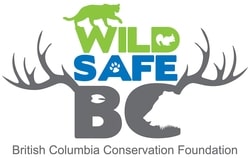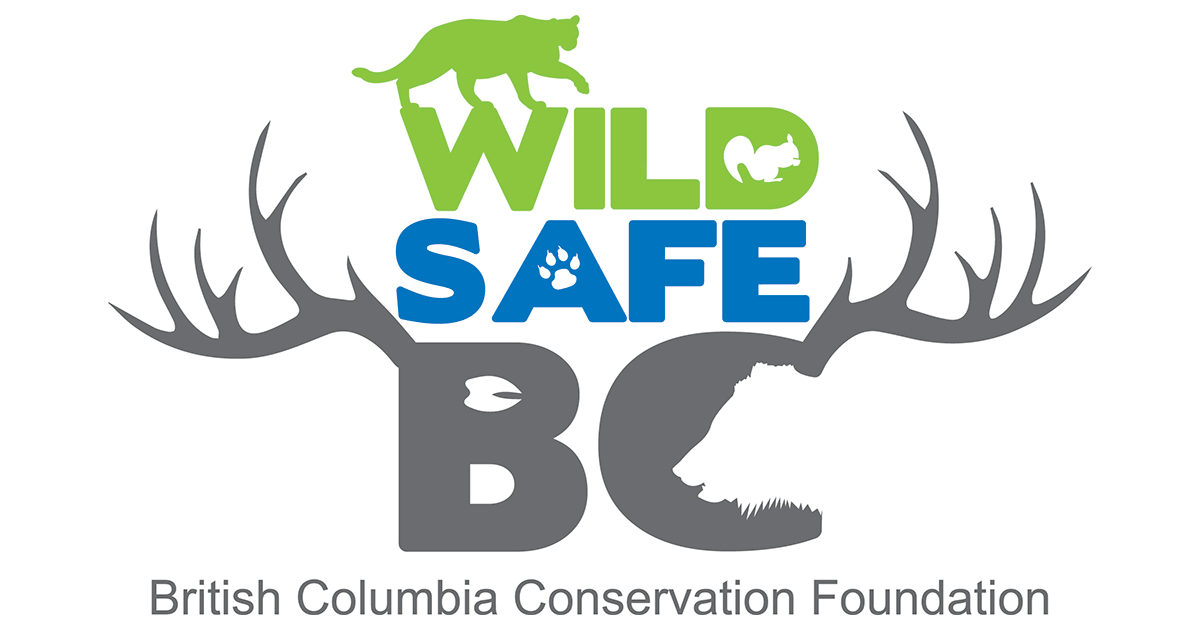Reducing Conflict Where We Grow

Many of the foods we grow and landscaping choices we make are also attractive to wildlife. Before conflicts arise, learn about the wildlife in your area and what may draw them to your garden, beehive, orchard, vineyard, crop or livestock. Here are some general rules of thumb to begin:
1. Understand all you can about the wildlife you share the landscape with. The more you know about wildlife, the better you will be able to avoid conflict with it.
2. Understand that removing the wildlife is a short term solution. Other wildlife will take the place of the wildlife just removed - a longer term solution is to either manage the attractant or set up a barrier between the attractant and the wildlife.
3. Fencing (whether electric or conventional) is only effective if it is maintained. Ensure that regular maintenance is a part of your routine.
4. Understand the regulations (under the BC Wildlife Act) which spell out your rights and obligations with respect to protecting your crops and livestock from wildlife and, if in doubt, consult with a local Conservation Officer.
Landscaping for Reducing Conflicts
Wildlife often use landscaping for food, shelter and security cover when travelling. While attracting beneficial insects and providing habitat for birds is desirable, avoid providing food and shelter to potential conflict species by: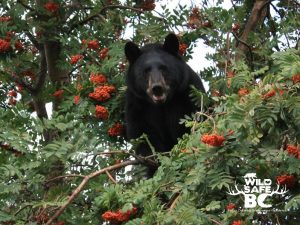
- Limiting or omitting the use of fruit-bearing plants that may be highly attractive to bears, raccoons, and even coyotes. If you must have fruit-bearing plants, ensure they are not located near building entrances and windows.
- Avoid nut-producing trees that can be highly attractive to bears.
- Trim trees and shrubs so as to remove branches that could provide security cover close to the ground.
- Design your yard with clear sight lines and avoid creating blind-spots that allow wildlife to hide.
- Remove tree limbs that are adjacent to your home that would provide access to your home by raccoons, rats or squirrels.
- Avoid using herbicides that are harmful to wildlife or local pets.
- Do consider native plants that are best adapted to your local growing conditions and will be beneficial to local pollinators.
- Consider fencing, both physical and electric, to prevent access by wildlife.
Special Note on Bears
Avoid planting native or non-native plants that are strong bear attractants near your home. These include fruit or berry producing trees and shrubs such as Sitka mountain-ash (Sorbus sitchensis), any of the blueberries and huckleberries (Vaccinium species) and ground covers such as the non-native clover and native sedges. Nut-bearing trees such as oak trees are also a strong attractant for bears.
Resources for Plant Selection in Bear Country:
City of Coquitlam Landscaping Guide
District of Squamish Landscaping Guide
Alberta Bow Valley Bear Smart Recommended Plant List Guide
Central Kootenay Invasive Species Society Eco Garden and Plant Lists
Special Note on Deer
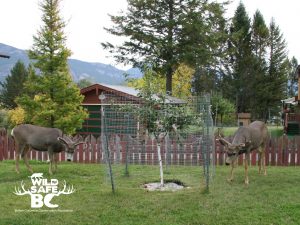
Unlike bears, deer are ruminants and capable of digesting a much wider variety of plants and shrubs. While some plants may be more “deer-resistant” than others, when deer are numerous or hungry, they may eat anything. The Master Gardeners Association of BC provides a “deer-resistant” plant list and suggestions.
In addition, using exclusion fencing can be effective at deterring deer. Check with local bylaws before erecting a new fence. Chain-link or page-wire fencing should be at least 2.5 m high on level ground. The wires need to be taut to avoid entanglement. Avoid barb-wire fencing and decorative wrought-iron picket fences that can injure deer and are not effective at discouraging deer from entering your property. Solid fences can be lower and still be effective as deer are less likely to jump into an area they cannot see. Flexible mesh netting can also be used but ensure deer cannot become entangled. Chicken wire can be used to wrap around trees and prevent deer from rubbing. In winter, shrubs and plants can be wrapped in burlap to prevent browsing.
Landscaping to Remove Cover for Wildlife
Trim trees and shrubs so as to remove branches that could provide ground cover. Design your yard with clear sight lines (don't have trees or shrubs that create blind-spots that allow wildlife to hide). Remove or limb trees that are adjacent to your home so as to prevent access points for arboreal animals such as raccoons, rats or squirrels.
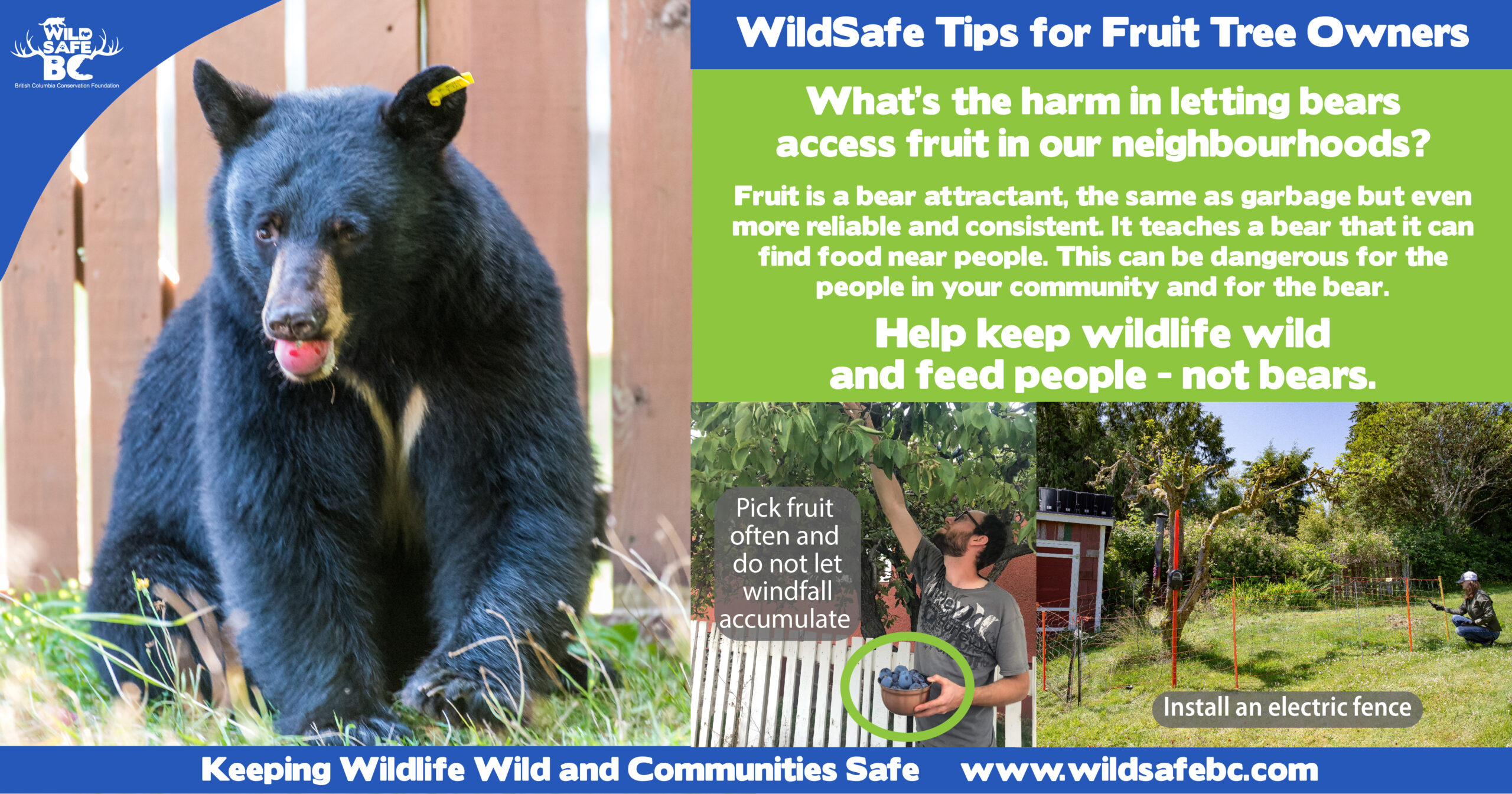 Fruit Trees
Fruit Trees
Domestic fruit trees such as apple, plum and cherry are unnatural food sources for bears and other wildlife. Introduced as agricultural crops, they are a strong attractant and can lead to food-conditioning. Wildlife that learn where they can access these foods are likely to return as harvest time approaches. They may even damage the trees and surrounding property in the process. We often plant fruit trees close to our homes for us to enjoy but this can also draw bears into our community and puts others at risk of a dangerous wildlife encounter. Once the harvest wanes, a food-conditioned and human-habituated bear may turn to other sources of food nearby such as garbage.
The best way to keep people and wildlife safe is to prevent wildlife from accessing human sources of food. There a number of strategies and solutions to not only prevent wildlife conflicts but also produce a healthier and more productive crop:
- Harvest fruit frequently and do not let it accumulate on the ground. Not only does this attract predators but it can lead to pest infestations and disease.
- Bears and other animals may go after fruit that is not fully ripe. They may also damage trees when climbing them to access the bounty. After checking local bylaws, consider using an electric fence that is effective at protecting the tree and allows time for the fruit to ripen. These can be installed temporarily or you can consider permanent installations if protecting other attractants.
- When composting fruit on site, do not add large quantities at once. Freeze most and add slowly. Do not compost infested fruit.
- If you have too much fruit, seek out local fruit tree projects or fruit-gleaning organizations, contact your local food bank, or reach out to local farmers that need feed for their livestock.
- Use the power of social media to connect with others to swap and share fruit and other produce. You may have apples to trade for tomatoes.
- Keep trees pruned and a manageable size. A well-pruned tree is often required to have better fruit.
- If you are no longer using the fruit and do not have time or capacity to care for it, consider removing the tree and replacing it with a species that does not bear fruit or nuts, one that is native to your area can be a good choice.
Note that many communities now have bylaws that require fruit trees be managed responsibly to prevent wildlife conflicts or to prevent the spread of pests and disease. Become informed about local regulations and learn more about how to maintain your tree through your local nursery.
Subsidy Programs
If you live in the Elk Valley, you can apply for a subsidy program to remove fruit trees that you are no longer able to manage. In addition, the District of Sparwood is offering a tree replacement grant for their residents. Email fernie@wildsafebc.com for more information.
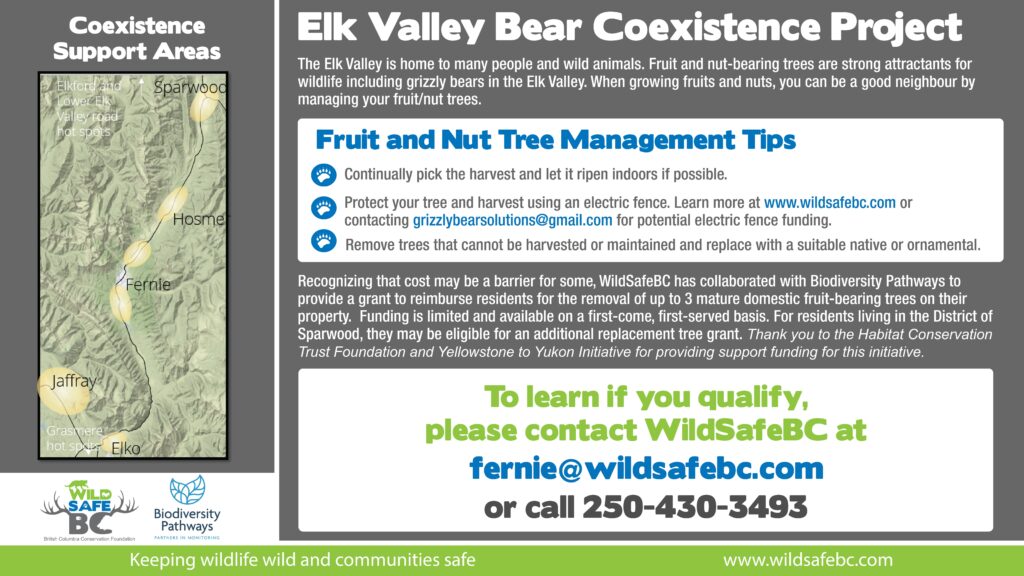

WildSafe Composting
Compost is a strong attractant for all types of animals from rats to bears. Ideally, when living in wildlife country, use a bear-resistant composter. These can also exclude many other types of animals. If this is not possible, make sure to keep your compost well-maintained with the following best practices:
- Use equal amounts of brown and green matter when adding to your compost
- Turn the compost regularly, all the way to the bottom to avoid rats from nesting
- Line the bottom of the compost with wire mesh to prevent rodents from digging into from the bottom
- Use lime to help reduce the acidity and odour
- Freeze abundant collections of fruit and add slowly to the compost
- Do not throw food scraps without burying them in the compost
- Never add meat, dairy, bones or grease
Community Compost Spotlight
The Villages of New Denver and Silverton are piloting a Community Composting Program in partnership with the Healthy Community Society of the North Slocan Valley and the Regional District of Central Kootenay. The goal of the program is to collect food waste in bear-resistant composters (Joracan) around the villages and turn it into high-quality compost which will be offered back to participants for their gardens. These bear-resistant containers are also effective at excluding rats and other wildlife species.
Each Joracan can service ~25-30 average house holds (fewer for those with large businesses also using the Joracans). Just over this last year (as of July 2021), the New Denver-Silverton program diverted approximately 38,500 litres and 21.35 tonnes of organic waste and created roughly 15,400 litres of high-quality compost for people’s gardens. Overall, there are now roughly 185 participants as well as the school/staff population of 115, within an area with ~1000 people. Additionally, education has been a big focus. Every child in the community from pre-school to grade twelve has been introduced to composting and understands how and why we compost and the science behind it.
Access the program brochure here and learn more by watching the video showcase below:
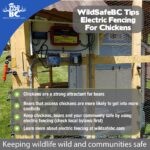 Keeping Urban Livestock and Bees
Keeping Urban Livestock and Bees
WildSafeBC understands and supports the concepts of local food security and we recognize that the raising of chickens and urban animal husbandry can be a part of a local food strategy. At the same time we would recommend that any production of food be done in a manner that is environmentally responsible and sustainable. Part of that responsibility lies in ensuring local food production does not create attractants for local wildlife and lead to conflict.
WildSafeBC does not take a stance on whether or not animal husbandry (keeping of chickens, goats, pigs, bees, etc.) should be allowed in a municipal setting. If a municipality does allow for it, then we encourage the adoption of bylaws that set out the following standards by which the practice can be undertaken. Please note that the recommendations are not meant to be exhaustive but only address those issues around reducing human-wildlife conflicts.
The following guidelines can only reduce conflict that will be created by allowing an attractant such as chickens within a community's boundaries. If farm animals are to be kept in an urban setting, then the following minimum guidelines should be observed:
- The raising of any domestic animals should be conducted in such a manner as to not attract wildlife.
- Specific measures that should be taken include:
- The enclosure should have a properly installed and well-maintained electric fence set up around its perimeter (refer to electric fencing).
- The enclosure should be built in such a way as to exclude larger wildlife such as fox, coyote, cougar even without the application of electric fencing.
- For chickens and small animals, a coop or hutch within the enclosure should provide the animals with a safe roosting/nesting area, be able to be closed for the night and be built so as to exclude small predators such as weasels, skunks or martens.
- Enclosures should be located away from cover and within good sight lines for people approaching the enclosure.
- Animals should be fed in such a manner as to ensure that no feed is left uneaten and available to wildlife. Feed which is not used by the animals should be cleaned out on a daily basis.
- All feed should be stored in airtight, wildlife-resistant containers in locations that are not easily accessed by wildlife.
- Any other wildlife attractants in close proximity to the enclosure must be managed so as not to attract wildlife to the enclosure
- In the event that the enclosure is breached by wildlife the incident should be reported immediately to the Conservation Officer Service Provincial hotline (1-877-952-7277).
